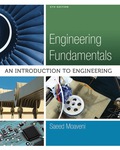
Concept explainers
Find the frontal area of the cell phone by excluding the display panel in SI unit and U.S. Customary unit.
Answer to Problem 49P
The frontal area of the cell phone by excluding the display panel in SI unit and U.S. Customary unit is
Explanation of Solution
Given data:
The height of the cell phone
The width of the cell phone
Formula used:
Formula to calculate the frontal area of the cell phone by excluding the display panel is,
Here,
Calculation:
Total frontal area:
Formula to calculate the total frontal area of the cell phone is,
Here,
Substitute
Area of the display panel:
Refer to the figure 7.49, the height and width of the cell phone is divided as slots. Therefore,
For 1 slot, the height is:
For 1 slot, the width is:
From the figure 7.49, approximately the number of slots in height of the display panel is 10, and in width of the display panel is 9.
Substitute the respective slot values in cm for the height and width of the cell phone.
Formula to calculate the area of the display panel is,
Here,
Substitute
Substitute
The SI unit of the frontal area by excluding the display panel is,
The U.S. Customary unit of the frontal area by excluding the display panel is,
Therefore, the frontal area of the cell phone by excluding the display panel in SI unit and U.S. Customary unit is
Conclusion:
Thus, the frontal area of the cell phone by excluding the display panel in SI unit and U.S. Customary unit is
Want to see more full solutions like this?
Chapter 7 Solutions
EBK ENGINEERING FUNDAMENTALS: AN INTROD
- Please draw shear and moment diagrams with provided information.arrow_forwardShow step by step solutionarrow_forwardDraw the shear and the moment diagrams for each of the frames below. If the frame is statically indeterminate the reactions have been provided. Problem 1 (Assume pin connections at A, B and C). 30 kN 2 m 5 m 30 kN/m B 60 kN 2 m 2 m A 22 CO Carrow_forward
- This is an old exam practice question. The answer key says the answer is Pmax = 52.8kN but I am confused how they got that.arrow_forwardF12-45. Car A is traveling with a constant speed of 80 km/h due north, while car B is traveling with a constant speed of 100 km/h due east. Determine the velocity of car B relative to car A. pload Choose a File Question 5 VA - WB VBA V100 111413 + *12-164. The car travels along the circular curve of radius r = 100 ft with a constant speed of v = 30 ft/s. Determine the angular rate of rotation è of the radial liner and the magnitude of the car's acceleration. Probs. 12-163/164 pload Choose a File r = 400 ft 20 ptsarrow_forwardPlease show step by step how to solve this and show formulararrow_forward
- Please solve this question step by step with dia gramarrow_forwardUse the second picture to answer the question, Thank you so much for your help!arrow_forwardP6.16 A compound shaft (Figure P6.16) consists of a titanium alloy [G= 6,200 ksi] tube (1) and a solid stainless steel [G= 11,500 ksi] shaft (2). Tube (1) has a length L₁ = 40 in., an outside diameter D₁ = 1.75 in., and a wall thickness t₁ = 0.125 in. Shaft (2) has a length 42 = 50 in. and a diameter d₂ = 1.25 in. If an external torque TB = 580 lb ft acts at pulley B in the direction shown, calculate the torque Tcrequired at pulley C so that the rotation angle of pulley Crelative to A is zero. B Te (2) TB (1) FIGURE P6.16arrow_forward
- 7.43 Neglecting head losses, determine what horsepower the pump must deliver to produce the flow as shown. Here, the elevations at points A, B, C, and D are 124 ft, 161 ft, 110 ft, and 90 ft, respectively. The nozzle area is 0.10 ft². B Nozzle Water C Problem 7.43arrow_forwardA 1.8m x 1.8m footing is located at a depth of 1 m below the ground surface in a deep deposit of compacted sand (f'= 33 , f' = 28 , γ = 17.5 kN/m). Calculate the ultimate net bearing capacity considering several factors (e.g., shape, depth, and inclination) when the groundwater table is located (a) at 5 m below the footing base, (b) at the ground surface, (c) at the footing base, and (d) at 1.5 m below the footing base. Also, explain the effects of the groundwater levels in the bearing capacities of the footing with your own words. If the information is not given for the calculation, please assume it reasonably.arrow_forward7.18 Determine the discharge in the pipe and the pressure at point B. Neglect head losses. Assume α = 1.0 at all locations. 1.5 m Water B 3.5 m 40 cm diameter -20 cm diameter nozzle Problem 7.18arrow_forward
 Engineering Fundamentals: An Introduction to Engi...Civil EngineeringISBN:9781305084766Author:Saeed MoaveniPublisher:Cengage Learning
Engineering Fundamentals: An Introduction to Engi...Civil EngineeringISBN:9781305084766Author:Saeed MoaveniPublisher:Cengage Learning Residential Construction Academy: House Wiring (M...Civil EngineeringISBN:9781285852225Author:Gregory W FletcherPublisher:Cengage Learning
Residential Construction Academy: House Wiring (M...Civil EngineeringISBN:9781285852225Author:Gregory W FletcherPublisher:Cengage Learning

